Expert Interviews
- University Reviews
- Career Guide
 Video Counseling
Video CounselingImportant Facts
- Ask any Question - CV Forum

What Is Project Management? - Definition, Tools, Process, Courses, Jobs [2025]
College Vidya Team Jan 15, 2025 3.1K Reads

Companies and organisations, ranging from small start-ups to large corporate firms, have various projects and operations that must be handled by experienced professionals. Whether it be a single, one-time project that a company invests in or whether it is an on-going endeavour towards an efficient company functioning through its various projects, the role of project management is crucial for success. So if you are someone who sees themselves handling the responsibilities of and managing big company projects, then this blog is here to give you detailed insights into this professional field.
What is Project Management? Definition and Examples
Before venturing into any field or professional domain, it is understandably important to know the nature of the domain as well as what it is all about. Project management is a subdomain of management and has been defined by the Project Management Institute (PMI) as “the use of scientific knowledge, skills, tools and techniques to deliver something of value to people.”
From this definition, it can be seen that project management includes:
- Use of Scientific Knowledge, Skills and Tools: Project Management as a field makes use of tools and knowledge that are rooted in scientific and standardised principles and practices which enable successful execution and growth of the company.
- Deliver Valuable Results: The primary goal of project management is to deliver valuable results that will enable the company to grow and meet the desired goals of the company.
Project management as a field, thus pertains to the regulation of flow, operations and resources in a project and involves a holistic management of multiple aspects to bring out the successful unfolding and implementation of these projects.
For example, if a company organises a project of launching a new product in the market, then effective project management would involve handling the various aspects involved in it such as the marketing of the product, the resources involved in manufacturing the product, its sales and advertising, customer reviews, feedback and evaluation of the steps involved in the process, management of the various operations involved in the launch and so on.
Project management as a professional domain can include 2 types of management:
- Management of a One-Time Project: This involves single projects that project managers handle, in which a single aim is sought by the company heads with specific goals and timelines. Examples of this type of projects include SEO projects aimed for a specific campaign, product launch in the market, thematic advertising campaign etc.
- Continuous Project Management: This includes the continuous management of certain aspects of company functioning and the various projects involved in them. For example, the continuous management of SEO projects of the company may be considered as a prolonged and continuous project management.
Explorer Some Trending Online Management Courses
| General Management | Finance Management | HR Management |
| Hospitality Management | Marketing Management | Operations Management |
| Business Analytics | Power Management | Retail Management |
Project Management Process- The Project Life Cycle
The process of project management, like any other process of managing an operation or organised activity, has certain stages that it passes through to move towards completion. Project management as a process has multiple aspects that must be carefully assessed and evaluated at each stage and accordingly adapted for successful outcomes. The entire process of project management and the lifecycle of a company project can be divided into 5 broad categories/stages based on the Project Management Body of Knowledge (PMBOK) given by PMI:
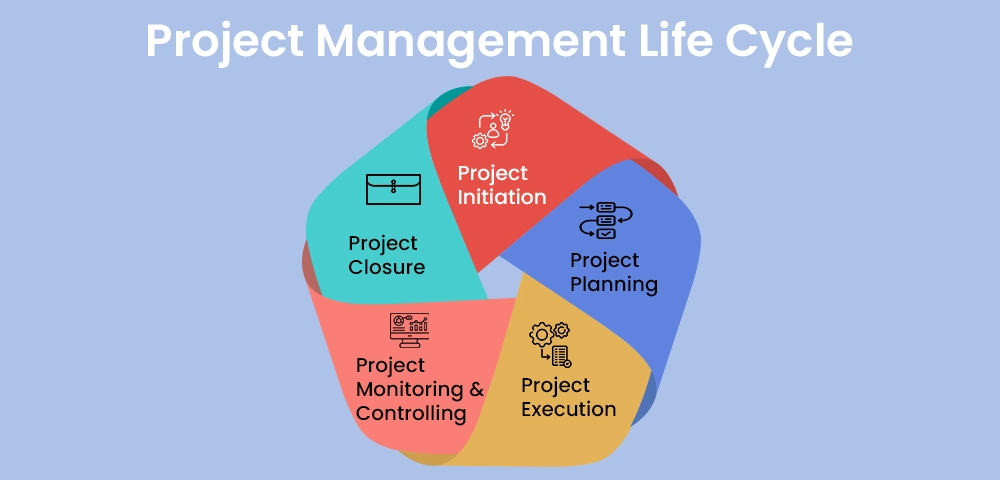
1) Project Initiation
The very first stage of project management is the preliminary proposal of a project. Project initiation includes all the aspects involved in proposing a project and formulating a basic structure for it. There are certain key aspects involved in project initiation which have been mentioned here:
- Defining the Project Goals: Before starting out on a company project, it is essential to propose a rationale for the same. A proposed project should enable the company to attain certain tangible and intangible goals. Projects should be designed to serve larger company goals and seek growth.
- Creating a Business Case: Proposing a business case involves putting the project in the broader context of business goals and company benefits. Any project that you propose to conduct should meet larger business goals and proposing your business case includes explaining the same, i.e. how your project helps the company to grow and prosper.
- Preparing the Project Charter: The project charter is an overall summarisation of the entire project in terms of the goals it proposes to fulfill, the various aspects and operations involved in it, expected timeline in which the project can be expected to complete, the various constraints and challenges involved in it and so on.
- Laying Out the Stakeholders: The last step of project initiation is to list out all the stakeholders involved in the project, i.e. all the individuals who participate as well as are affected by the project such as the workers involved in various stages of the project, the trustees and individuals investing in the project, the customers or clients involved and so on.
So, project initiation includes the preliminary proposal for a project idea as well as giving it a basic concrete structure from a conceptual idea.
2) Project Planning
Project planning involves adding the nuances to the project such as the technical aspects involved in it, the various resources that will be needed to implement the project, the detailed timeline of the project, the various operations that will be involved in the project, the roles and responsibilities that are to be divided among the various units and employees and so on. This is one of the most detailed parts of project management and takes the most time to implement. There are various aspects involved in it such as:
- Creating a Project Plan: The first step in further planning the project is to create a detailed map of the project in terms of the various technical, logistic and operational details. This includes creating a detailed framework that consists of the various steps and aspects which will be involved in implementing the project, the various resources and amenities that will be needed to complete the project, the subgoals that will be involved in the project and so on. The various goals that are set at this stage for the various departments and units must be designed so that they are sustainable and realistically achievable, timed appropriately and sustainable.
- Setting a Budget Plan: This is one of the most crucial aspects of the project because the resources and budget allocated to it will eventually affect all the other aspects including the timeline, the rigour and complexity level of the project, the sales and advertising involved in the project (if applicable) and so on. The budget outline and plan would also depend upon factors such as the funding allocated to it, the company goals it helps to achieve and its scope for growth and profits.
- Defining Roles and Responsibilities: Another crucial aspect of project planning, this involves meticulously dividing the various work roles, responsibilities and operative functions between the relevant departments, teams and individuals. The responsibilities should be delegated in a realistic, fair and achievable manner to the employees.
3) Project Execution
Project execution is the stage of project management in which all the project plans and functions are implemented in the company by the various stakeholders. This stage involves execution of the plans of action and has multiple aspects to manage such as ensuring the efficient flow of resources and responsibilities as needed, integrated and cooperative functioning of the units, proper communication between various departments and units, effective implementation of operations and so on.
4) Project Monitoring and Controlling
This is a continuous step in project management but becomes most crucial once the major implementation of project tasks and goals begin. Project controlling and monitoring involves continuous evaluation of how the project tasks are carried out, if the required standard of quality for the same are being maintained, if all the departments and involved teams are working in-sync and integrated manner and so on. This step is highly essential throughout the entire lifecycle of the project and helps to ensure that the involved stakeholders do not deviate from the established standards of execution, the resources are used optimally as well as the goals of the project are being effectively met.
5) Project Closure
This is the last stage of a project management process and reflects the period when the project is about to close and terminate after successful completion. This period, although the last stage of project management, has many aspects that need to be looked after. Firstly, project managers after successful completion of the project need to ensure that all the external contracts involved in the project have been terminated as per the company policies. Secondly, another aspect to look into is whether all the resources have been utilised effectively in the project. For this, project managers often conduct meetings with the stakeholders involved to discuss the project goals that were completed, the various challenges that were faced during implementation, reports of employee performance in the project, reports for the costs incurred in the project and so on. Such a meeting about all the aspects of the project is important to understand the overall effectiveness of the project in meeting company goals.
Detailed Example of the Project Management Process
If a company decides to launch a new product in the market, then this project will be handled by the project managers and will require close and careful strategizing and planning.
- The project initiation will include a mapping of the project goals, i.e. why the company has decided to launch the specific product in the market.
- Then the project manager must propose an effective business case, such as by explaining how the product will help the company to grow and prosper in the current market trends and situation.
- The next step will be to prepare the project charter for the same which will lay out the important goals and structures involved in the project launch, the challenges such as market competitors, current economic situation of the market etc. that can be faced upon launching the product as well as the rough timeline within which the successful launch can be planned and executed.
- The next step is to plan the nuances of the product launch. For example, the project manager will create the project plan in which the steps for launching the product, the logistics and operations involved in it, the various resources that will be utilised in the launch etc. will be listed out.
- The next step at this stage is to approximately lay out a budget outline of the product launch so as to evaluate if it is possible for the company to allocate the estimated budget or not and accordingly plan the campaign ahead.
- The project plan also lays out a structure about how the roles and responsibilities involved in the product launch will be divided. The roles and tasks are delegated to the respective units and teams and the subgoals and deadlines provided to each accordingly.
- After the project goals have been set, the project plan prepared and budget outline provided, the next step is to actually implement the various steps and courses of action.
- The project managers must continuously monitor and evaluate the actions of various teams and whether the goals and deadlines for the launch are being met effectively.
- It is also important to ensure at this point that the departments and teams involved in the product launch are coordinating and working integratedly to achieve the goals set by the managers.
- After the product launch has been successfully conducted, the project management process reaches towards its conclusion. At this point, the managers should create an overall report and conduct a meeting with all the stakeholders of the product launch to discuss the total costs incurred in the launch, the challenges faced, the goals met as well as the overall outcomes such as customer response, customer feedback, sales etc.
Tools Used in Project Management
The purpose of using tools in project management is to make the process easier to track as well as manage at various stages. Project management tools are designed to effectively organise the entire project lifecycle and the various aspects involved in it in a systematic manner. Such tools not only ease the process for the project managers but are also very beneficial for the various stakeholders and members of various teams to keep track of their own deadlines and progress. There are a number of tools that can be used by project managers at various stages of the project lifecycle. Different tools may be helpful to varying degrees depending on the purpose of use, intended audience and so on.
Some of the most commonly used tools in project management have been listed here.
1) Network Charts
A network chart or a network diagram is a visual framework in which there are various segments divided on the basis of various teams, responsibilities and operations of the project, which are connected by arrows to indicate the desired workflow as well as sequence of operations to be followed for the most efficient execution of the project. The use of network charts is primarily done to visualise the pathways and dependencies of workflow that are to be maintained. Softwares that can incorporate animations or changes in the network chart can be used to highlight the functions that have been fulfilled followed by those that need to be completed.
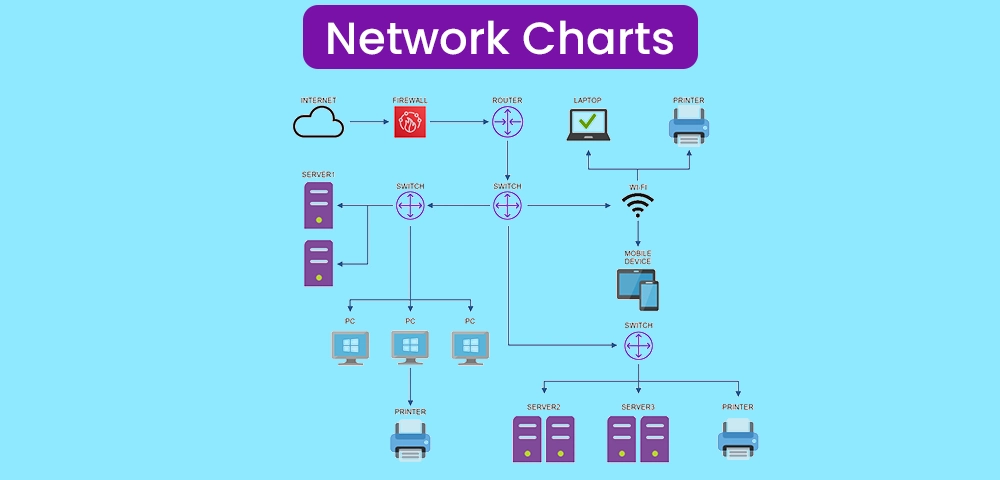
You can use various softwares such as Microsoft Vision, Intermapper, SmartDraw etc. to create personalised network charts for managing your projects.
2) Kanban Board
A kanban board is another visualisation tool used in project management to show the multiple aspects of the project. It is also used to limit the work-in-progress. A kanban board helps to track the operations being performed by various teams and departments in real time, as it is used to set realistic and achievable goals and limit the works-in-progress of various teams. A kanban board has various sections for visual signals (which includes the various tasks undertaken at the moment by the time), columns (which visualise the workflow), work-in-progress limits (showing the maximum visual signals for one team), commitment point (where new ideas are accumulated for further projects) and delivery point (which includes the final result that the team must deliver for the project).
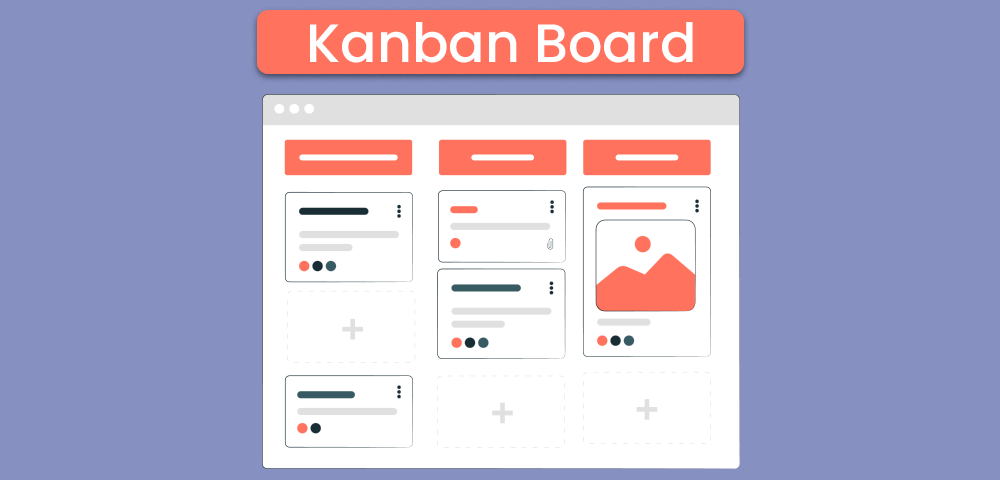
There are various softwares that can be used to prepare kanban boards for your projects such as Trello, Microsoft Project, Kanbanize, Wrike etc.
3) Critical Path Method
A critical path method is rather a method of managing a project than a tool. The CPM involves identifying the longest workflow sequence that has been charted in the network diagram mentioned above. This critical path exemplifies the most crucial operation flow of the project in which the longest devotion of time and resources is needed. So, it is important to track and monitor how the critical path work functions are being completed and whether the tasks are being completed as per the set deadlines or not. A CPM is commonly used to track the longest chain of activities in the project and ensure that there are no delays in the fulfillment of task goals in that chain.

You can use softwares like Zoho Projects, LiquidPlanner, nTask, Wrike etc. for creating and tracking the critical paths in your project.
4) Gantt Charts
A gantt chart is an innovative visual representation tool used in project management to represent the amount of time dedicated to a certain task/operation as well as the amount of work that has been completed for that function. A gantt chart consists of a number of horizontal bars that represent the deadlines set for an operation as well as how close a team is to achieving those deadlines. In many new softwares, there are a number of features that also help to represent the members and teams dedicated to each of the operations as well as the individual tasks each member is allotted. Thus, a gantt chart is helpful in visualising the work done by each member in the project and track the overall progress of the team.
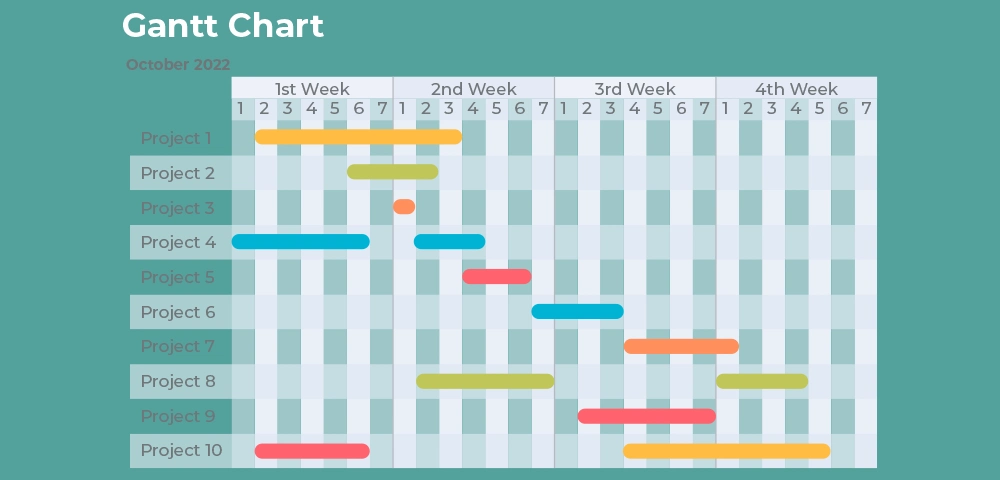
There are many available softwares for preparing gantt charts for projects such as Microsoft Project, Microsoft Excel, GanttPro, TeamGantt etc.
5) Work Breakdown Structure
A Work Breakdown Structure (WBS) is a tool similar to the network diagram but instead of highlighting the workflow, it highlights the various work goals and deliverables to be achieved. As the name suggests, a WBS breaks down the broader goal of the project into various levels of goals, subgoals, as well as micro level goals. A WBS is used to highlight the various goals that must be met by the teams and departments at various levels for the successful implementation of the project. There are various levels into which the task goals are divided:
- Project title and goals: This highlights the broad project goals that have to be met at the macro level.
- Task: This highlights the broad divisions of the tasks that will be included in the project in terms of project initiation, task planning, execution, monitoring and controlling. This level also highlights the various broad domains of functions that are handled by the various departments in the project.
- Subtasks and Work Packages: This is the most foundational level of goals that have to be fulfilled at the micro level by the teams and employees involved with the project. The subtasks and work packages can be easily assessed in terms of stipulated time needed, resources needed and so on. These are the most basic tasks that must be completed to achieve the higher level of the goals.
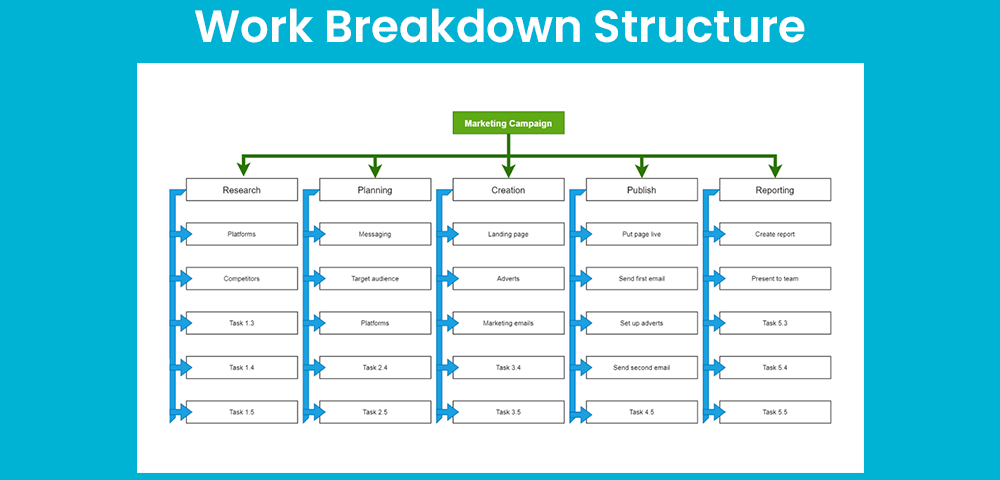
Various tools available for creating Work Breakdown Structures (WBS) include those like Creately, GanttPro, LucidChart etc.
6) Dashboards
Work dashboards are real-time tools that visualise all the aspects of a project including the tasks being performed by various units and teams, the costs and resources being incurred on the tasks, overall progress towards full goal completion, workload on employees and so on. Overall, a project dashboard represents various such factors through pie charts, colourful bar diagrams and easy to understand tables. A dashboard is especially helpful when the project managers wish to track the progress in real-time and incorporate changes accordingly in the project.

Softwares like Monday.com, Asana, Workflow, Celoxis, ProWorkFlo etc. can be used to create and maintain company dashboards for various projects.
7) Timesheets
Timesheet is a tracking tool that can be used in project management as well as any other administrative function to track and monitor the time dedicated by employees on various tasks. A timesheet is useful to track the hours that employees dedicate to tasks essential for executing the project on a daily, weekly or monthly basis. Timesheets have been used for a variety of official functions and are undoubtedly a useful tool in project management when employees need to dedicate a minimum period of time to a task on a daily or weekly basis.
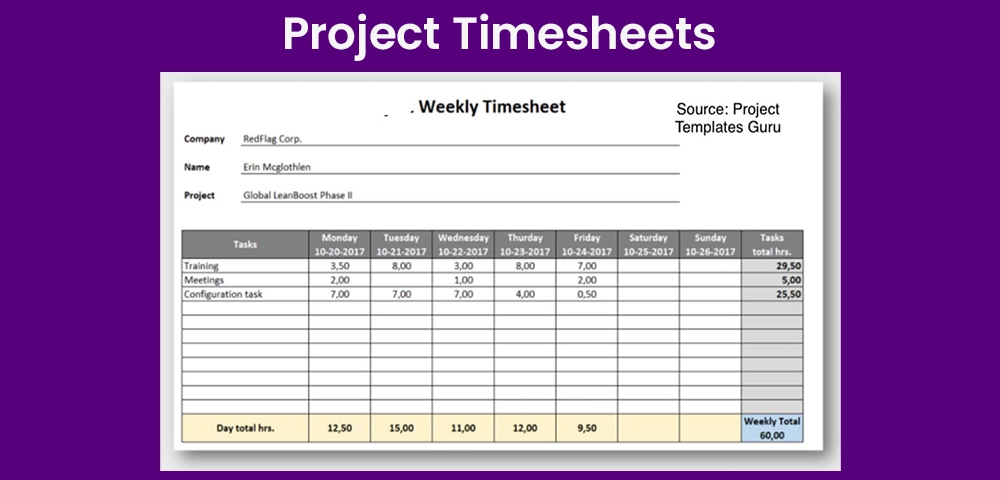
Many companies may have physical, written timesheets for tracking employee performances. However, many softwares are available today such as Zoho Projects, Toggl, Avaza, Replicon etc. which can be used for maintaining employee timesheets.
8) Project Evaluation and Review Technique
A Project Evaluation and Review Technique (PERT) tool is used along with a network diagram to identify and track the critical path in the diagram. It is also used to evaluate the approximate time period that will be needed to complete the critical path and the other workflow pathways by taking into account the likelihood of various constraints affecting them. A PERT tool is unique in that it incorporates the aspects of various constraints affecting the workflow and makes a realistic assumption of the likely timeline needed to finish the tasks and consequently the project. Some softwares that can be used to prepare PERT charts include Adobe Express, Miro, Creately, SmartDraw etc.
9) Project Documentation
Project documentation is a tool that can be used in the final stages of project management to systematically represent all the data related to the project and report the status of the project. The project documentation usually includes all the important details regarding the status of various goals of project management, the resources utilised in it, the performance details of the various teams and departments and so on. Project documentation helps to communicate to the various stakeholders and company heads the details, costs and outputs of the project. Some of the common softwares and tools that help to systematically document a project include Asana, Confluence, Wrike, Monday.com etc. Some of the top softwares that can be used for project management include those like Trello, MS Project, Asana, Zoho, Wrike, Skype for Business etc. There are many upcoming tools and softwares coming up with new and innovative technologies and features to provide the best user experience to project managers and teams.
Explorer Career Oriented Article
Methodologies of Project Management
When it comes to the specific approaches to project management, there are a number of methodologies that a project manager can take up. There are many popular project management methodologies. The most frequently used ones have been mentioned here with examples.
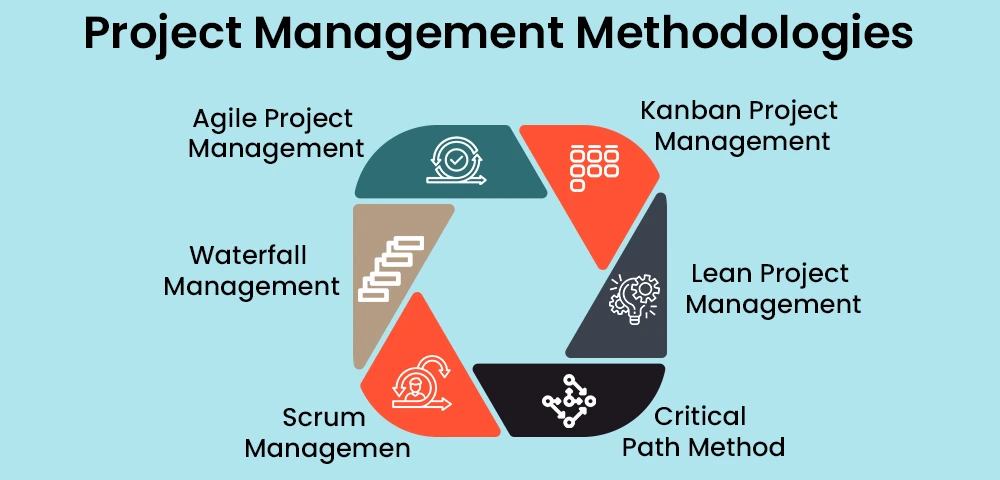
1) Waterfall Management
This is one of the most frequently used and organised methodologies of project management. The “waterfall management” is named so as the chain of activities and operations in this approach are arranged in a top-bottom flow order, i.e. there are clear steps and hierarchies in work order. The entire set of tasks of the project management are arranged in clearly defined steps and stages through which work flows. These steps are sequential in nature in that one step or task can only be completed once the previous ones have been successfully implemented. As a result, there is a dependence between the various units that perform the different functions. For example, if an SEO project follows a waterfall approach in project management, then the project will involve a clear hierarchy of steps such as the written content being prepared by writers, followed by the search engine optimisation of the content, creation of graphical content accordingly and finally launching the content and the campaign. Here, all the tasks are arranged in a hierarchical order- the SEO functions and the graphical functions cannot be performed until the written content has been completed. Thus, the tasks and steps are sequential.
2) Scrum Management
Scrum management is another approach to project management in which the work flow for the project is completed in repeated cycles. There is usually a scrum master who coordinates the entire group and the tasks and responsibilities in the project are performed in the form of short work cycles called “sprints”. This methodology involves a rapid and multidimensional approach in which the tasks being performed are not dependent on each other as there are a number of small teams in which the tasks are performed in short, repeated sprints.
For example, if the project under consideration is a product launch, then the scrum approach will include forming various small teams responsible for handling various aspects of the launch such as advertising, marketing, social media promotion, manufacturing of products, delivery and related services, customer services, legal aspects involved in the launch etc. These teams will then perform rapid functions in their domain as well as coordinate with the other units and work in-sync to effectively launch the product. The main aim of a scrum approach is to speed-up the project management process and the execution of it. The scrum master of each team enables the members to work rapidly and effectively towards the daily goals and deadlines by overcoming the setbacks to it.
3) Critical Path Method (CPM)
This approach to project management involves the aspect of identifying the most crucial aspects of the project. After the various critical aspects of the project have been identified, the project managers have the task of closely monitoring the progress of these functions and aspects. This approach involves breaking down the project into the various constituent domains, managing the most crucial aspects of it, with a focus on the deliverable aspects of the project. CPM is usually useful in projects which have a short and rigid deadline. Such projects also have a structured schedule which must be closely followed. The major aim of this approach is to identify these various crucial aspects of the project, ensure that these activities and functions are completed without failure, the deadlines are met effectively, and the company goals, especially the deliverables, are met successfully.
For example, in the case of a project involving a product launch, one of the main aims is effective delivery of the product to customers. In this case, a CPM approach can be used to identify the crucial aspects related to deliverables involved in the launch. Close monitoring along with continuous assessment of the progress towards the deadlines and goals can then be conducted to ensure that the product is launched successfully.
4) Extreme Programming (XP)
This is a fast-paced approach to project management when the goals for the project must be completed on a rapid basis as the outcome is needed in a short interval. In this approach, the work and tasks for the project must be completed within a very tight schedule. Hence there is an increased focus on short work cycles, in which there are phases of planning, execution, monitoring and evaluation. The short-term goals are met through these work cycles, which ultimately are integrated to produce the broader output.
For example, if a project regarding a crash-course in training of employees in using a particular software is to be completed in a short-term basis, like 2 weeks, then the XP approach can be used. For effective implementation and training, the entire workforce can be divided into small teams, each of which are taught the use of the software in short cycles. This can be followed by training and hands-on practice sessions. All such sessions, when conducted in the form of short practice cycles, can lead to effective training and learning of the software, which is the ultimate goal of the project.
5) Lean Project Management
A lean project management is a methodology in which the managers try to minimise all the wasteful and unnecessary steps, operations and enhance the productivity of the members involved in the project. This approach was originally proposed by Henry Ford as a way to reduce the wastes in the form of physical by-products. The central idea of this methodology is to increase the simplicity of the operations and project to create a ‘lean’ framework and project plan. A few of the wasteful practices in project management that must be avoided include:
- Operations that lead to unneeded overproduction
- Operations that strain the existing resources for the project
- Operations that utilise resources without producing proportionate outcomes etc.
The aim of a lean methodology is to ensure that the above wasteful practices are avoided, and the goals and successful outcomes of the project are achieved effectively in a simplistic manner.
For example, if a marketing project is managed by the lean project approach, then a few of the notable features of the methodology would include evaluating the necessary and effective marketing strategies that can be used to maximise sales and decrease expenditure on marketing practices that do not convert into sales etc. The plan for implementing the project will include a simple framework of marketing involving basic but successful
6) Kanban Management
Kanban management is another approach in project management wherein the managers use softwares to visualise the various parts, steps and aspects of the project. This approach can essentially be used with any other methodology of project management since it allows the managers to visualise and represent the various aspects, operations and challenges involved in the project in a visual and easy to follow format. The kanban method is often used by managers to systematically lay out the various aspects involved in the project in a visual format.
Some of the common aspects that are often highlighted in a Kanban board include:
- Various operations involved in the project
- Current work-in-progress
- Steps of Workflow
- Timeline of the Project
- Feedback Loops for Evaluation etc.
A Kanban approach can be used along with any other project management approach. For instance, if a marketing launch project is using the Kanban approach, then the managers can prepare a Kanban board wherein they can visualise the various important aspects of the project such as the stakeholders involved in the project, the various operational aspects that need to be handled by the various teams and departments, the resources allocated to each operation, current works-in-progress for the various tasks, the feedback loop for all the marketing campaigns in the project and so forth. The visual representation can aid in better understanding and tracking the progress and successful completion of various tasks of the project.
7) Agile Project Management
Agile project management is a comparatively newer approach to project management. This approach is centred around the idea of quickly and efficiently incorporating changes in the project throughout its lifecycle. So, in agile project management, the various process of the project are subdivided into constituent phases, and various teams work simultaneously on these aspects, communicate with each other regarding improvements and iterations, and incorporate rapid and efficient changes and improvements at various stages of the process. As per the Agile Manifesto of Software Development (2001), the 4 core values of the agile project management approach are:
- People and interactions over processes and tools
- Customer collaboration over contract negotiations
- Working software over comprehensive documentation
- Responding to change over following a plan
As can be seen, these 4 principles clearly highlight the importance of collaboration, communication, simplistic and minimalistic procedures, and responsiveness and adaptability to change, which are the central ideas of an agile approach to project management.
For example, if a website launch project follows an agile approach, then it will include various teams such as an IT and tech team, a front-end team, a back-end team, a website development team, a digital team etc. involved in simultaneously working on the various aspects of the website, working in collaboration and providing feedback and suggestions for improvement to each other. This agile approach will ensure that there is constant communication and feedback loops established to deliver a better outcome.
Any organisation while selecting the right approach to project management should take into consideration a number of factors such as the size of the project, the goals it seeks to achieve, the stakeholders involved, the workflow it wishes to achieve (e.g. linear and hierarchical vs non-linear, interwoven) and so on.
Project Management Top Trending Courses 2025
When it comes to upskilling yourself in the domain of project management, there are numerous options available. However, you must choose the course that is best suited for your educational and career demands. Whether you are a fresher, a student aspiring for a career in management or a working professional who has already established your foot in the domain of management, there are endless options of top valued courses in project management.
Here we have provided you an overview of some of the top valued courses in project management in 2025:
1) MBA in Project Management
This is one of the most lucrative courses in the field of management and with a specialisation in project management, it can be one of the best educational and career choices for your successful future. Today, there are numerous colleges that offer an MBA course. But for some students and working professionals, pursuing a regular MBA can be tough to manage. As a measure to enable more students and working professionals to take up an MBA course of their dreams, top universities are now providing options for pursuing fully online MBA degrees in project management. What’s more, these degree courses are also approved by UGC-DEB and hold equal value and validity as regular MBA degrees.
An online MBA in project management has a duration of 2 years. The average fee for an online MBA course can range from between INR 50,000 to INR 3,00,000. MBA project management graduates can explore good career options in MNCs, corporate firms as well as the public sector and can secure handsome pay packages as well.
2) Post Graduate Diploma in Project Management
A Post Graduate Diploma (PGD) in Project Management is a course which is considered as an equivalent to an MBA course. A PGD in Project Management has a similar curriculum and academic rigor as an MBA degree and equips the students with the fundamentals of management and project management in particular. This course is also offered by top management institutions and B-schools such as Symbiosis Institute of Management Studies (SIMS) and can be very helpful in starting or boosting your career in project management.
There are diploma courses available in project management in the online learning (OL) as well as Open Distance Learning (ODL) mode as well, which can be flexibly taken up by students and working professionals without the hassles of attending a regular college. The fee range for a PGDM course in Project Management can range from around INR 1,00,000 to INR 20,00,000 depending upon the chosen university or the mode in which you take up the course. After completing this course, you can explore project management or management related job options in the private and public sectors with satisfactory scope of growing your career.
3) Diploma Courses in Project Management
Some diploma courses may also be offered as the foundation in management and project management which can be taken up by students and interested learners after completion of HSC (10+2) education. Diploma courses in project management can be a good option for those who don’t want to invest a long period of time in pursuing the course.
A diploma course in project management is short-term, varying from between 3 months to 1 year, and introduces you to all the basic concepts and areas of the discipline. A diploma in project management can be a good addition to your educational qualifications in addition to other major degrees. The average course fee for a diploma in project management can range between INR 30,000- INR 1,00,000. Today, with the advent of technology-supported measures for learning, many colleges and institutes are also providing online diplomas for this stream of study. Distance diploma courses are also available.
4) Certificate Programme in Project Management
Certificate programmes are one of the best ways to enhance your knowledge and skills in a short duration of time and can be the best choice for you if you are a student who wants to upskill alongside a main degree or a working professional who is established in their career but wants to venture into this domain.
Project Management Certification Courses in the offline (regular) mode, online mode or ODL mode are provided by many top universities in India at the undergraduate and postgraduate levels. These courses have a short and crisp curriculum, which is industry-oriented and helps you to kickstart your career in this field easily with the relevant skills needed for growth. The duration can vary between a few weeks to a few months, with the fee ranging approximately between INR 20,000 to INR 80,000.
5) MOOCs on Project Management
Massive Open Online Courses (MOOCs) are essentially certification programs which can be completed via fully online modes. These courses in project management have a duration ranging from a few weeks to 6 to 18 months as well. There are many MOOC platforms such as Upgrad, Coursera, edX etc. that provide students with MOOCs in project management which can be taken up virtually to obtain online certifications.
So there are many courses and numerous options available for upskilling if you want to study project management and hone your knowledge and skills in the domain. You can choose the best-suited option for yourself depending upon your budget, the time you wish to invest in the course as well as your level of completed education and career progress. At College Vidya, we provide you a UGC-DEB approved and accredited list of courses in the online mode in project management, be it fully-fledged online degrees or short-term certificate courses for upskilling. The “Compare” portal of College Vidya helps you to compare these courses easily on a number of parameters such as fee range, approvals, student ratings and much more.
Explorer Popular Online Degree Courses
| Online MBA Program | Online Executive MBA | Global MBA Program |
| Online MA Program | Online MCA Program | Online M.Sc Program |
| Online BBA Program | Online BA Program | Online BCA Course |
Roles and Responsibilities in Project Management
Before venturing into the field, it is a good idea to explore the various roles and responsibilities that a project manager has to fulfill as it will help you to visualise better if this career is indeed suited for you or not.

As we have already discussed, project managers have the overall responsibility of handling and managing a company project, and hence it involves a number of roles and responsibilities to fulfill along with it:
- Project managers prepare the initial blueprint of the project and the rationale behind the project along with other stakeholders.
- Project managers also prepare the entire strategy of the project including the various goals, the roles and responsibilities of each department and team and so on.
- Project managers map out the resources available for the project as well as how they can be utilised at various steps of the project.
- A project manager also divides and delegates responsibilities to the teams and units that will be involved in the project.
- A project manager manages and monitors the progress of the project as well as whether the deadlines are being met regularly.
- A project manager communicates with all the team heads to ensure individual teams are meeting their task deadlines as well.
- A project manager also ensures that the resources allocated to each of the tasks and operations are being utilised appropriately to meet the desired goals.
- Project managers have the responsibility of monitoring not only the deadlines and progress of the project but also the quality of various tasks and goals being met since the quality of the project is also an essential aspect of any project.
- A project manager also handles issues that may arise with clients and customers as well as addresses their grievances and helps seek quick and efficient solutions.
- A project manager has the responsibility of motivating and leading the team effectively so that they are inspired to work and achieve the successful implementation of the project.
- Project managers also have the responsibility of supervising the interactions and integrating the functions of the various teams and departments to ensure smooth progress of the workflow.
- The project manager has the responsibility of addressing and managing the problems or issues that may arise during the course of the project.
- A project manager also has the responsibility of collecting and reporting all the information regarding the progress of the project in a systematic manner.
- Finally, a project manager communicates the results and outcomes of the project to the stakeholders and company authorities in the form of a project report.
So, as can be seen, a project manager has responsibilities to fulfill from the very conception of the project till the project is concluded and the outcomes and results communicated to the stakeholders and company authorities. The role and responsibilities of a project manager are very dynamic and fluid in nature. The above list of responsibilities gives a glimpse of the various domains of tasks that a project manager may be involved in. However, this is not an exhaustive list of responsibilities and project managers may have to adapt their role and responsibilities depending on the type of project they are working on, available resources, the teams they are working etc.
Project Management Top Jobs and Salary 2025
There are a number of job options available for professionals with a qualification in project management. There are many top MNCs and corporate companies that hire project managers to handle and deliver successful projects for company and business growth. Some of the prospective job options in the field of project management along with the average salaries offered in India have been listed here for you:
| Job Role | Average Salary P.A |
| Project Management Consultant | INR 9,00,000 |
| Project Risk Manager | INR 12,00,000 |
| Project Manager | INR 15,00,000 |
| Project Cost Manager | INR 19,00,000 |
| Project Planner | INR 15,00,000 |
| Project Analyst | INR 7,00,000 |
| Project Leader | INR 10,00,000 |
| Director of Operations | INR 30,00,000 |
Top Recruiters in Project Management
Some of the top recruiting companies where project managers can explore job options include MNCs and corporations of global repute. Here we have listed down the top 10 companies that hire project managers and provide them with excellent scope of growing their career:
| Capgemini | Accenture | WIPRO |
| KPMG | Boston Consulting Group | TCS |
| InfoEdge | Verizon | Deloitte, IBM etc. |
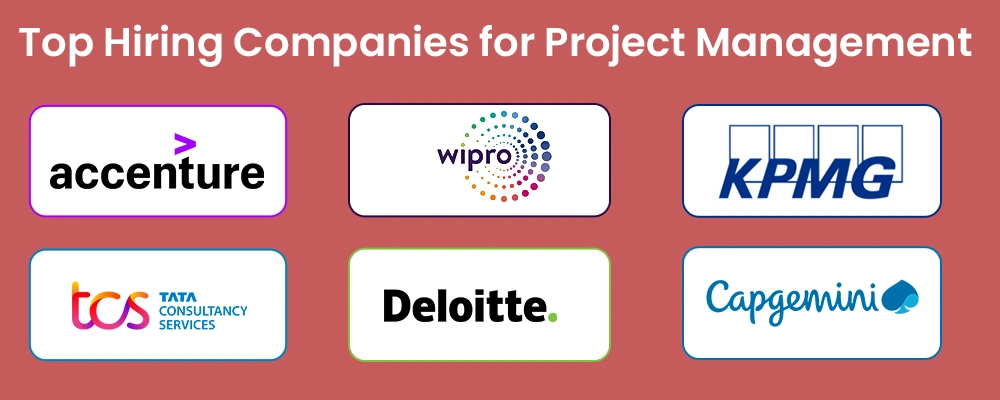
Explorer Some Trending Article On Management
Project Management vs Product Management- Know the Difference
The role of a project manager and a product manager are closely related in many cases and so may be confusing for many. However, there are some distinct differences between these two fields and job roles. Here we have tried to provide you with a simplified difference between these terms:
- The role of a project manager is primarily concerned with the overall supervision and management of a company project. On the other hand, a product manager is involved in the overall management of the process of making a product or service.
- For example, a project manager may be involved in the management and supervision of the organisation of a company seminar with top clients. On the other hand, a product manager may be involved in the production and launch of a new product in the market.
- In some cases, a project manager may handle the responsibilities of a product manager whereas the vice versa may not be true in most cases. For example, a project manager may handle projects related to the production and launch of products and services. However, a product manager usually does not handle the diverse types of projects that a project manager is involved with.
- A product manager is usually involved in the broad strategizing and planning of a product launch or service but a project manager is more involved with the actual operational aspects of such strategies and plans at a grassroot level. So, while a product manager plays a more strategic role in an organisation, the project manager plays a more executionary role in the organisation.
FAQs (Frequently Asked Questions)
Project management, as defined by the Project Management Institute (PMI) is "the use of scientific knowledge, skills, tools and techniques to deliver something of value to people.” Project management involves working towards the successful implementation of a company project by integrating all the aspects like operations, coordinated team functioning, resource utilisation and so on to produce final broader outcomes.
Tools in project management are used to visualise the various aspects of a project like the operations to be performed, the teams and departments that will be involved in the project, the resources that will be spent in the project and so on. Some project management tools include network diagrams, gantt charts, Critical Path trackers, work breakdown structures, project dashboards, timesheets etc.
The 5 main processes involved in project management include project initiation, project planning, project execution, project monitoring and controlling and lastly project closure. Each of these stages further include various subdomains and aspects that need to be looked at before progressing to the next stage.
Project management can be of various types such as waterfall project management, scrum project management, agile project management, kanban project management, critical path method, extreme programming method, lean project management etc.
The various stages of a project management life cycle include the project initiation, project planning, project execution, project monitoring and controlling and project closure. Each stage involves careful strategizing, planning, implementation and close evaluation and adaptation.
Yes, project management is a good field if you are interested in managing micro to macro aspects of valuable company projects. Project management is a good field of management to venture into since there are ample job options in the public and private sector for this discipline as well in domains like risk management, strategic planning, risk analysis, quality management etc. of projects. The salaries offered to qualified professionals in this field is also substantially high, starting from around INR 6 LPA and hiking up to INR 30 LPA at the managerial and top positions. Top companies like Accenture, TCS, WIPRO, Deloitte, KPMG etc. hire project managers for handling their company projects.
There are a large number of job options after specialising in project management. You can explore public and private sector jobs in the field. You can take up job roles such as project risk analyst, project manager, project management consultant, project leader etc. in the domain of project management. The salaries offered in this domain can range from INR 6 LPA at beginner positions upto over INR 30 LPA for mid to top management positions.
Yes, as per the latest guidelines by UGC-DEB, an online MBA in Project Management is a valid and credible degree course when completed from a duly accredited institution of higher education. It is not only valid but also of equal value as an offline and regular MBA degree as ascertained by UGC-DEB.
Some of the top private MNCs and companies hiring project managers in India include KPMG, TCS, WIPRO, Accenture, Deloitte, Boston Consulting Group, Capgemini etc.

Idea Alchemist / Concept Creator / Insight Generator
We are an online education platform where users can compare 100+ online universities on 30+ X-factors in just 2 minutes. With an active CV community, we have transformed online learning to quite an extent. With the CV Subsidy scheme, we contributing to GER in India while helping our learners with their finances in their “Chuno Apna Sahi” journey!
Every query is essential.
Our team of experts, or experienced individuals, will answer it within 24 hours.
Recommended for you
Tired of dealing with call centers!
Get a professional advisor for Career!
LIFETIME FREE
Rs.1499(Exclusive offer for today)

Pooja
MBA 7 yrs exp

Sarthak
M.Com 4 yrs exp

Kapil Gupta
MCA 5 yrs exp
or



Career Finder
(Career Suitability Test)
Explore and Find out your Most Suitable Career Path. Get Started with our Career Finder Tool Now!
ROI Calculator
Find out the expected salary, costs, and ROI of your chosen online university with our free calculator.
